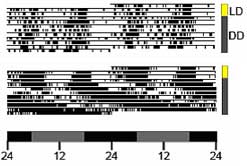| RIKEN Center for Developmental Biology (CDB) 2-2-3 Minatojima minamimachi, Chuo-ku, Kobe 650-0047, Japan |
The comparatively simple Drosophila genome provides an excellent model for studying the elaborate network of circadian controls in human, as it is more comprehensively characterized, more amenable to experimentation, and many circadian genes are known to be conserved between these two apparently dissimilar species. A genome-wide analysis of the Drosophila genome by DNA microarray revealed on the order of 200 genes whose expression in head regions exhibited 24-hour cyclical patterns of expression. To pull out the central players from this set of candidates, the lab next screened for phenotypes using RNA interference (RNAi), which allowed them to study the effects of the tissue-specific loss of function of individual genes in vivo. Watching for disturbances in the normal behavioral patterns of flies, the team observed five RNAi phenotypes marked by dramatic changes in circadian rhythmicity. Of these, the gene with the most pronounced effect on biological clock activity was found to code a transcriptional factor containing a basic helix-loop-helix and an ORANGE domain, leading to its colorful name, clockwork orange, in reference to the Anthony Burgess novel and Stanley Kubrick film of the same title. The Ueda team then looked for possible targets of CWO using a combination of microarray and chromatin immunoprecipitation technologies, also known as ChIP-on-chip, to isolate and identify DNA-binding proteins with an affinity for clockwork orange. An assay of the full Drosophila genome showed that CWO binds to a number of E-box genes, which are known to play a key role in the transcriptional network that regulates the body’s internal clock. They also determined that CWO negatively regulates the expression of numerous clock genes, including its own, and that loss of cwo function results in the halving of the daily amplitude of oscillatory clock gene expression in comparison to wildtype. This may be attributable to a loss of the normal inhibition of direct CWO targets, resulting in a reduction of the thresholds in their transcriptional control and as a consequence, an elevation of their trough expression levels. These latest findings from the Ueda team indicate that the novel gene clockwork orange interacts closely with other known clock genes and plays an important role in the maintenance of circadian rhythmicity, highlighting the power of such advanced methodologies as DNA microarrays, RNAi and ChIP-on-chip in addressing complex biological networks. “The work is still far from complete,” says Ueda, “but I feel the discovery of clockwork orange, which has a homolog in the human genome as well, represents an important step in deciphering biological clocks at the systems level.”
|
|||||
|
|||||
 |
| Copyright (C) CENTER FOR DEVELOPMENTAL BIOLOGY All rights reserved. |
